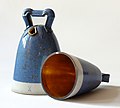
A carillon ( KARR-ə-lon, kə-RIL-yən) is a pitched percussion instrument that is played with a keyboard and consists of at least 23 bells. The bells are cast in bronze, hung in fixed suspension, and tuned in chromatic order so that they can be sounded harmoniously together. They are struck with clappers connected to a keyboard of wooden batons played with the hands and pedals played with the feet. Often housed in bell towers, carillons are usually owned by churches, universities, or municipalities. They can include an automatic system through which the time is announced and simple tunes are played throughout the day.
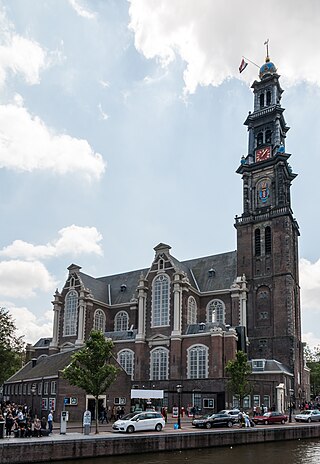
The Westerkerk is a Reformed church within Dutch Protestant Calvinism in central Amsterdam, Netherlands. It lies in the most western part of the Grachtengordel neighborhood, next to the Jordaan, between the Prinsengracht and Keizersgracht.

Campanology is the scientific and musical study of bells. It encompasses the technology of bells—how they are founded, tuned and rung—as well as the history, methods, and traditions of bellringing as an art.

A bell tower is a tower that contains one or more bells, or that is designed to hold bells even if it has none. Such a tower commonly serves as part of a Christian church, and will contain church bells, but there are also many secular bell towers, often part of a municipal building, an educational establishment, or a tower built specifically to house a carillon. Church bell towers often incorporate clocks, and secular towers usually do, as a public service.

Paula Modersohn-Becker was a German Expressionist painter of the late 19th and early 20th century. She is noted for the many self-portraits the artist produced, including nude self-portraits. She is considered one of the most important representatives of early expressionism, producing more than 700 paintings and over 1000 drawings during her active painting life. She is recognized both as the first known woman painter to paint nude self-portraits, and the first woman to have a museum devoted exclusively to her art. Additionally, she is considered to be the first woman artist to depict herself both pregnant and nude and pregnant.
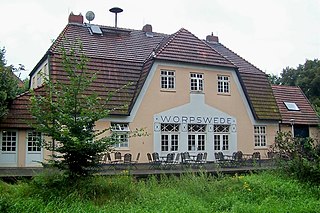
Worpswede is a municipality in the district of Osterholz, in Lower Saxony, Germany. It is situated in the Teufelsmoor, northeast of Bremen. The small town itself is located near the Weyerberg hill. It has been the home to an artistic community since the end of the 19th century.

Ludwig Roselius was a German coffee merchant and founder of the company Kaffee HAG. He was born in Bremen and is credited with the development of commercial decaffeination of coffee. As a patron, he supported artists like Paula Modersohn-Becker and Bernard Hoetger and turned the Böttcherstrasse street in Bremen into an artwork.

Bernhard Hoetger was a German sculptor, painter and handicrafts artist of the Expressionist movement.

Bremen, officially the City Municipality of Bremen, is the capital of the German state of the Free Hanseatic City of Bremen, a two-city-state consisting of the cities of Bremen and Bremerhaven. With about 570,000 inhabitants, the Hanseatic city is the 11th largest city of Germany and the second largest city in Northern Germany after Hamburg.

Memorial Tower, or the Campanile as it is sometimes called, is a 175-foot clock tower in the center of Louisiana State University's campus in Baton Rouge, Louisiana, United States. Erected in 1923 and officially dedicated in 1926, it stands as a memorial to Louisianans who died in World War I.
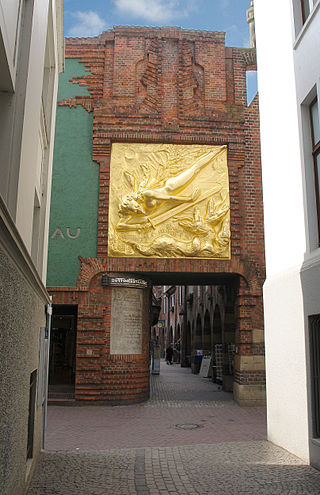
Böttcherstraße is a street in the historic centre of Bremen, Germany. Only about 100 m (330 ft) long, it is famous for its unusual architecture and ranks among the city's main cultural landmarks and visitor attractions. Most of its buildings were erected between 1922 and 1931, primarily as a result of the initiative of Ludwig Roselius, a Bremen-based coffee-trader, who charged Bernhard Hoetger with the artistic supervision over the project. The street and its buildings are a rare example of an architectural ensemble belonging to a variant of the expressionist style. Several of the houses can be classed as Brick Expressionism. Since 1973, the ensemble has been protected by the Monument Protection Act.
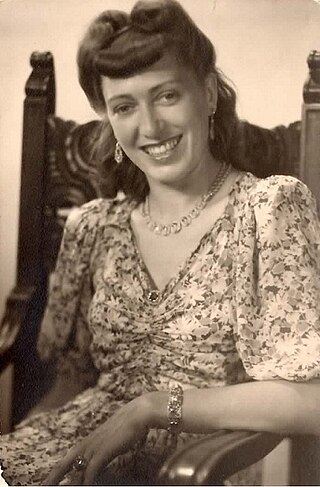
Barbara Goette was a German academic. She lived in Germany and then Australia. From 1935 to 1943, she was the private secretary of Ludwig Roselius, creator of Böttcherstraße and Café HAG, and financier of Focke-Wulf.

The Atlantis House on Böttcherstraße in the old town of Bremen in the north of Germany is an interesting example of German architecture in the interwar period. Designed by Bernhard Hoetger, it was completed in 1931. After suffering serious war damage, it was rebuilt in 1965 with a new facade designed by Ewald Mataré.

The Ludwig Roselius Museum on Böttcherstraße in the old town of Bremen, Germany, houses the private collection of the successful coffee merchant Ludwig Roselius (1874–1943). Artefacts from the Middle Ages to the Baroque period are on display. The house itself which was completed in 1588 has a history going back to the 14th century.

Robinson Crusoe House is a stepped-gabled house on Böttcherstraße in the old town district of Bremen, Germany. It was built by the prosperous coffee merchant Ludwig Roselius who admired the pioneering spirit of Daniel Defoe's fictional hero Robinson Crusoe.
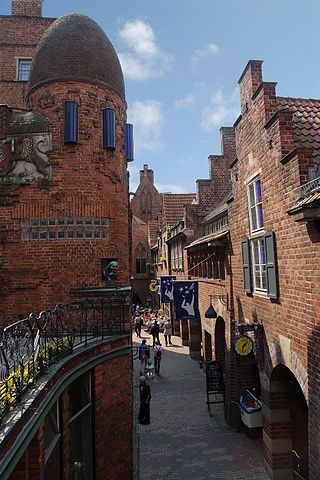
St Petrus House is a historic building in Bremen, Germany. With features of North-German Gothic architecture including an arcade, it was built in 1927 by the prosperous coffee merchant Ludwig Roselius as part of his development of Böttcherstraße. Today its newly refurbished dining rooms are part of the Atlantic Grand Hotel. Since 1973, St Petrus House has been a listed building.

The House of the Seven Lazy Brothers is a historic building in Bremen, Germany, completed in 1927. With a name based on a local legend, the building located in Böttcherstraße in the old town was built by the prosperous coffee merchant Ludwig Roselius to a design by Bremen architects Eduard Scotland and Alfred Runge. The first version of the house was home to the advertising department of Roselius's coffee company and the Deutscher Werkbund association of craftsmen. When it was rebuilt in 1954 the new design was based on a traditional local story.

Eduard Scotland (1885–1945) was a German architect active in Bremen. He is remembered in particular for the Böttcherstraße houses he and his associate Alfred Runge built for the coffee merchant Ludwig Roselius.

Alfred Runge (1881–1946) was a German architect active in Bremen and its surroundings. He is remembered in particular for the Böttcherstraße houses he and his associate Eduard Scotland built for coffee merchant Ludwig Roselius.

